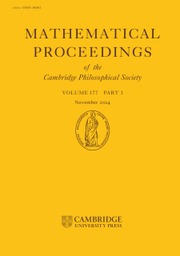Crossref Citations
This article has been cited by the following publications. This list is generated based on data provided by Crossref.
Kurdachenko, Leonid
and
Otal, Javier
2013.
The rank of the factor-group modulo the hypercenter and the rank of the some hypocenter of a group.
Open Mathematics,
Vol. 11,
Issue. 10,
Ballester-Bolinches, A.
Camp-Mora, S.
Kurdachenko, L.A.
and
Otal, J.
2013.
Extension of a Schur theorem to groups with a central factor with a bounded section rank.
Journal of Algebra,
Vol. 393,
Issue. ,
p.
1.
Dixon, M.R.
Kurdachenko, L.A.
and
Otal, J.
2015.
On groups whose factor-group modulo the hypercentre has finite section p-rank.
Journal of Algebra,
Vol. 440,
Issue. ,
p.
489.
Detomi, Eloisa
Morigi, Marta
and
Shumyatsky, Pavel
2015.
On countable coverings of word values in profinite groups.
Journal of Pure and Applied Algebra,
Vol. 219,
Issue. 4,
p.
1020.
Pypka, O. O.
2017.
On the Relationships Between Central Series in Some Locally Finite Groups.
Ukrainian Mathematical Journal,
Vol. 68,
Issue. 10,
p.
1659.
de Melo, Emerson
Lima, Aline de Souza
and
Shumyatsky, Pavel
2018.
Nilpotent residual of fixed points.
Archiv der Mathematik,
Vol. 111,
Issue. 1,
p.
13.
Rezig, Aziza
and
Trabelsi, Nadir
2018.
Groups with many subgroups having polycyclic-by-finite layers or derived subgroup.
Communications in Algebra,
Vol. 46,
Issue. 3,
p.
1344.
Acciarri, Cristina
Shumyatsky, Pavel
and
Silveira, Danilo
2019.
Engel sinks of fixed points in finite groups.
Journal of Pure and Applied Algebra,
Vol. 223,
Issue. 11,
p.
4592.
Dixon, Martyn R.
Kurdachenko, Leonid A.
and
Subbotin, Igor Ya.
2019.
Groups whose factor group modulo the upper hypercenter is of finite 0-rank.
Communications in Algebra,
Vol. 47,
Issue. 2,
p.
553.
DETOMI, ELOISA
MORIGI, MARTA
and
SHUMYATSKY, PAVEL
2022.
ON THE RANK OF A VERBAL SUBGROUP OF A FINITE GROUP.
Journal of the Australian Mathematical Society,
Vol. 113,
Issue. 2,
p.
145.
Acciarri, Cristina
Guralnick, Robert
and
Shumyatsky, Pavel
2022.
Coprime automorphisms of finite groups.
Transactions of the American Mathematical Society,
Vol. 375,
Issue. 7,
p.
4549.
Taghavi, Yasaman
and
Kayvanfar, Saeed
2024.
Bounds for the Generalization of Baer’s Type Theorems.
Bulletin of the Malaysian Mathematical Sciences Society,
Vol. 47,
Issue. 2,


